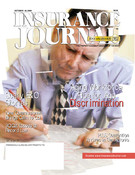On Oct. 20, Insurance Commissioner Harry Low took a much-needed first step to improve the dire state of California’s workers’ comp market.
Low approved the Workers’ Compensation Insurance Rating Bureau of California’s (WCIRB) proposed 10.1 percent average increase in pure premium rates, effective Jan. 1, 2001.
“The increase is due in large part to worsening severity in medical costs,” Low stated. “…Everyone should understand that the pure premium rates that I approve are advisory only and that they are, by law, only loss costs and loss adjustment expenses-I believe that open rating will work in the long run only if insurers act responsibly and charge rates that reflect their actual costs.”
California has been following a system of open rating since 1995. Over the last several years, significant downward deviation from the pure premium rate has contributed to serious problems in the state’s workers’ comp environment.
“What’s happening in the market doesn’t necessarily reflect its way into rates, because what we propose and the Commissioner approves or modifies is advisory loss cost,” said Dave Bellusci, senior vice president and chief actuary of the WCIRB. “So essentially what drove the increase of that magnitude was what we’ve been seeing in growth in the average cost of claims, particularly on the medical side, but to a lesser extent on indemnity as well.”
California workers’ comp medical costs soared to a record $3.6 billion last year, an increase of more than $1.5 billion since 1994, according to the CWCI’s latest accident year ultimate incurred cost estimates. Medical care costs for injured workers fell 36 percent from 1991 to 1994 as California’s economy suffered a severe economic downward spiral.
But in the mid-’90s, both physician costs, as well as hospital, med-legal, pharmacy and other medical expenses bottomed out and began a rapid upward climb.
Jack Hannan, WCIRB director of communications, outlined how the WCIRB arrived at the final proposal. “We started out in July with our typical yearly rate filing. Initially it was a 5.5 percent increase, but at that time we told the Insurance Department that we were seeing some increasing medical claims development that was somewhat greater than what we had used to predict that 5.5 increase. So we told the Department that we were going to take a look at one more quarter’s worth of data when it was available and that…we may want to revise our advisory pure premium rate filing.”
Interim Insurance Commissioner J. Clark Kelso scheduled a public hearing on Sept. 21. By then, the WCIRB had that extra quarter’s worth of data on hand, and “in fact we did amend our filing to 10.1 percent,” Hannan said. “That’s what the Commissioner felt was appropriate and that’s what he approved. Pretty much everything that we proposed in the filing was adopted by the Commissioner except for the provisions for the handling of partially fraudulent claims.”
There was no dispute at the hearing concerning the percentage increase, indicating a general consensus that rates are inadequate in California and still need to go up, according to Hannan.
California is currently facing the highest combined ratio ever seen for workers’ comp. The WCIRB estimates ultimate loss ratios of 108 percent and 115 percent for 1998 and 1999, which produces combined loss and expense ratios of 149 percent for 1998 and 153 percent for the 1999 accident year. “That’s really a factor of two things,” Bellusci pointed out. “One is the severity trends that form the basis of our 10.1 percent increase, and the other, which isn’t reflected in the increase, is the market discounting that’s going on in the pricing.”
But just because the Commissioner has approved the pure premium rate increase doesn’t mean that insurers will jump to raise rates. “Typically companies will be making their filings within the next month with the Department of Insurance,” Bellusci said. “They may take all of the 10.1, more, less, depending on what they view their need to be. But these are really just kind of benchmarks that are out there. To what extent they reflect themselves in market rates is always uncertain.”
Hannan said that pure premium rate is viewed as kind of a starting point. “They load a lot of other things on top of those rates… We have a very competitive market in California, so even with these increases, a lot of insurers may not be charging the full pure premium rate for some classifications. Insurers can charge whatever rate they feel is appropriate.”
However, the Commissioner’s approval of the increase is a step in the right direction, according to Bellusci. “Clearly the kind of combined ratios we’re projecting for 1999-can’t be sustained indefinitely, so I would view this as generally pretty positive for the industry.”
Topics California Trends Workers' Compensation Pricing Trends
Was this article valuable?
Here are more articles you may enjoy.


 Hurricane Beryl Triggers Record Payout for Caribbean Insurer
Hurricane Beryl Triggers Record Payout for Caribbean Insurer  Favre Wants Appeals Court to Reinstate Defamation Suit vs. Shannon Sharpe
Favre Wants Appeals Court to Reinstate Defamation Suit vs. Shannon Sharpe  Elon Musk Beats $500 Million Severance Lawsuit by Fired Twitter Workers
Elon Musk Beats $500 Million Severance Lawsuit by Fired Twitter Workers  Damage From Hurricane Beryl May Cost Insurers $2.7B in US, $510M in Caribbean: KCC
Damage From Hurricane Beryl May Cost Insurers $2.7B in US, $510M in Caribbean: KCC 


